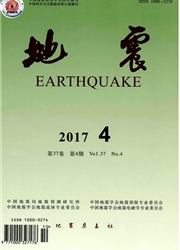

 中文摘要:
中文摘要:
本文系统介绍了金沙江水网6口观测井水位与水温动态对日本9.0级地震的同震响应,分析了同震响应的特征与同震响应的机理。结果表明,4口井水位有同震响应,同震响应形态全是振荡,对地震波响应的时间、振荡的幅度、振荡的持续时间等的差异主要取决于井一含水层系统的导水系数。结果还表明,3口井水温有同震响应,响应形态是不对称的V字或u字形;水温的先期下降是井筒内上(冷)下(热)水混合作用引起的,后期上升是井水与围岩之间的热传导引起吸热作用的结果,各井水温升降的幅度、持续时间等不同,主要是井水温度梯度与水岩热传导系数不同引起的;后期升幅总是大于先期降幅,这可能与地震波作用使井区大地热流增强有关。
 英文摘要:
英文摘要:
Coseismic responses of water level and temperature in 6 wells of Jinshajiang groundwater observation network to the Japan Ms9.0 earthquake are presented, and response characteristics and mechanism are analyzed. The analytical results show that (1) Whether or not there is water level response depends to a large extent on the height of water pillars in a well, and there are coseismic responses of water level in 4 wells with oscillation pattern, but the beginning time, extent and the continued time of oscillation is different in different wells, and these differences depends chiefly on the transmissibility coefficient of the well-aquifer system; (2)(3)There are coseismic responses of water temperature in 3 wells with response pattern of non-symmetry "V" or "U" forms, and front drop is related with the mix of upper water(with high temperature)and lower water(with lower temperature)in a well,the rise in later stage is related with the conduction of heat between water in wells and rock outside the well, and the extent of drop or rise of temperature and continued time are different for different wells, these difference depends probably on water gradient in well and heat conduction capability of water-rock system; and the extent of temperature change in later rise is always larger than that in front drop, probably related to the increase of geothermal flow caused by seismic wave effects .
 同期刊论文项目
同期刊论文项目
 同项目期刊论文
同项目期刊论文
 Tide-factor anomalies from observations of well level in the Sichuan Province prior to the great Wen
Tide-factor anomalies from observations of well level in the Sichuan Province prior to the great Wen Relationship between the Earth tidal factor and phase lag of groundwater levels in confined aquifers
Relationship between the Earth tidal factor and phase lag of groundwater levels in confined aquifers Co-Seismic Groundwater Level Changes Induced by the May 12, 2008 Wenchuan Earthquake in the Near Fie
Co-Seismic Groundwater Level Changes Induced by the May 12, 2008 Wenchuan Earthquake in the Near Fie Removing barometric pressure effects from groundwater level and identifying main influential constit
Removing barometric pressure effects from groundwater level and identifying main influential constit 期刊信息
期刊信息
